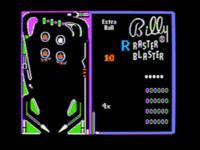Raster Blaster
| Raster Blaster | |
|---|---|
 | |
| Publisher(s) | BudgeCo |
| Programmer(s) | Bill Budge |
| Platform(s) |
Apple II (original) Atari 8-bit |
| Release | 1981 |
| Genre(s) | Pinball |
| Mode(s) | Single-player |
Bill Budge's Raster Blaster (or Rasterblaster on the disk label) is a pioneering home computer pinball simulation written by Bill Budge for the Apple II and published in 1981 by Budge's company, BudgeCo. It was ported to the Atari 8-bit family.[1] Raster Blaster resembles the Williams Firepower table from 1980.
While not the first pinball game for home computers, Raster Blaster set a higher bar for visual fidelity, and the next several years saw a flurry of Apple II pinball titles: David's Midnight Magic (1982), Night Mission Pinball (1982), and Budge's own Pinball Construction Set (1983).
Development
Raster Blaster presents a full screen high resolution display of a pinball game table. The 6502-based Apple II was not designed to support fast graphics and collision detection, but Budge mastered these problems and the game ran with such speed and visual accuracy that it stood head-and-shoulders above other arcade-style games of its day.
Electronic Arts (EA) was formed that same year, and founder Trip Hawkins was impressed by Budge's titles. He approached Budge (with the help of Apple Computer co-founder Steve Wozniak) and invited him to join the initial group of EA developers, and leave the manufacturing, marketing, sales and distribution issues behind. Budge agreed, and became the central figure among EA's highly publicized designers. Pinball Construction Set became a mainstream hit and the top title in EA's original line-up.
Reception
Debuting in April 1981, the game sold 25,000 copies by June 1982, tied for fourth on Computer Gaming World's list of top sellers.[2] BYTE praised the game's realistic physics, writing that "Most microcomputer games that are versions of existing board or equipment games aren't worth the disks they're printed on, but Raster Blaster does not fall into that category!"[3]
Raster Blaster was voted Softalk magazine's Most Popular Program of 1981.[4]
Softline stated when reviewing David's Midnight Magic that it "ratifies Bill Budge's extraordinary program as a programming tour de force" and "proof of Budge's technical lead over his rivals", as Midnight was merely equal to Raster Blaster despite being nine months ("an eternity in the Apple II world") newer.[5]
Compute! called the Atari version "addictive", although it noted some bugs.[6]
References
- ↑ "Raster Blaster". Atari Mania.
- ↑ "Inside the Industry" (PDF). Computer Gaming World. September–October 1982. p. 2. Retrieved 2016-03-28.
- ↑ "The Coinless Arcade". BYTE. December 1981. pp. 38–41. Retrieved 19 October 2013.
- ↑ "Most Popular Program of 1981: Raster Blaster!" Softalk. April 1982.
- ↑ Tommervik, Al (January 1982). "David's Midnight Magic". Softline. p. 32. Retrieved 13 July 2014.
- ↑ Kopp, G. L. (October 1982). "Raster Blaster". Compute! (review). p. 131. Retrieved 30 October 2013.